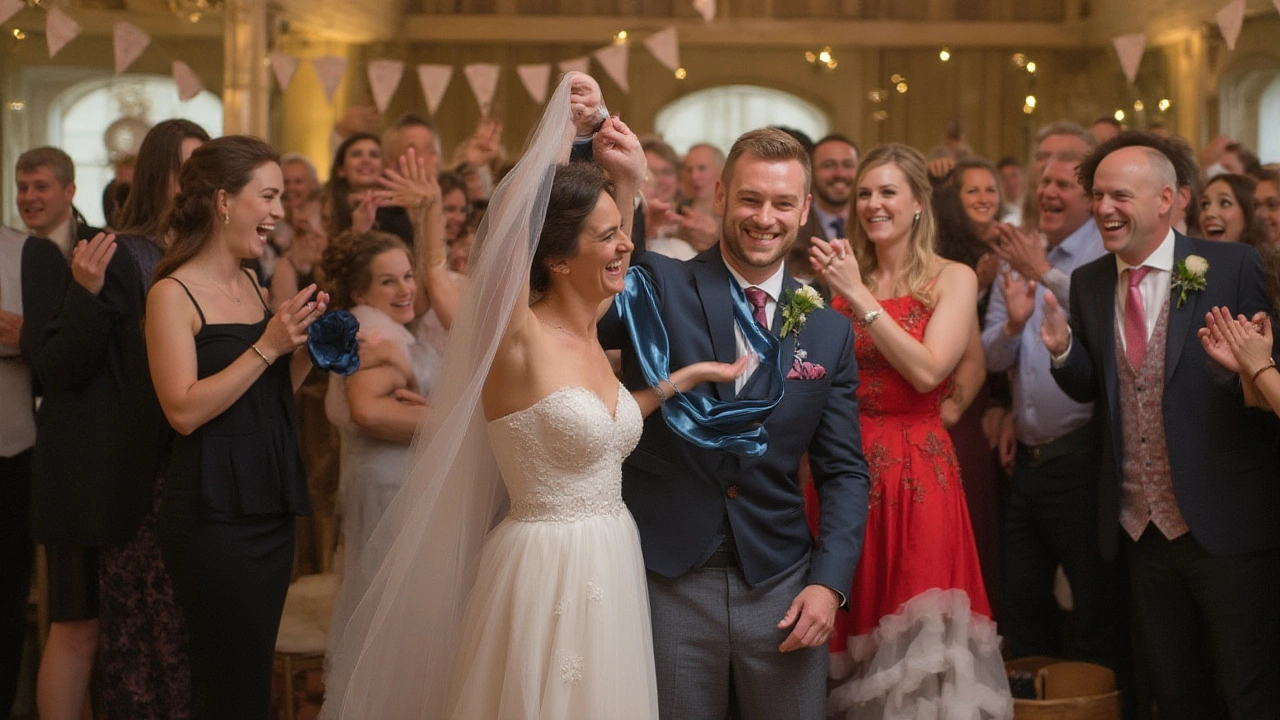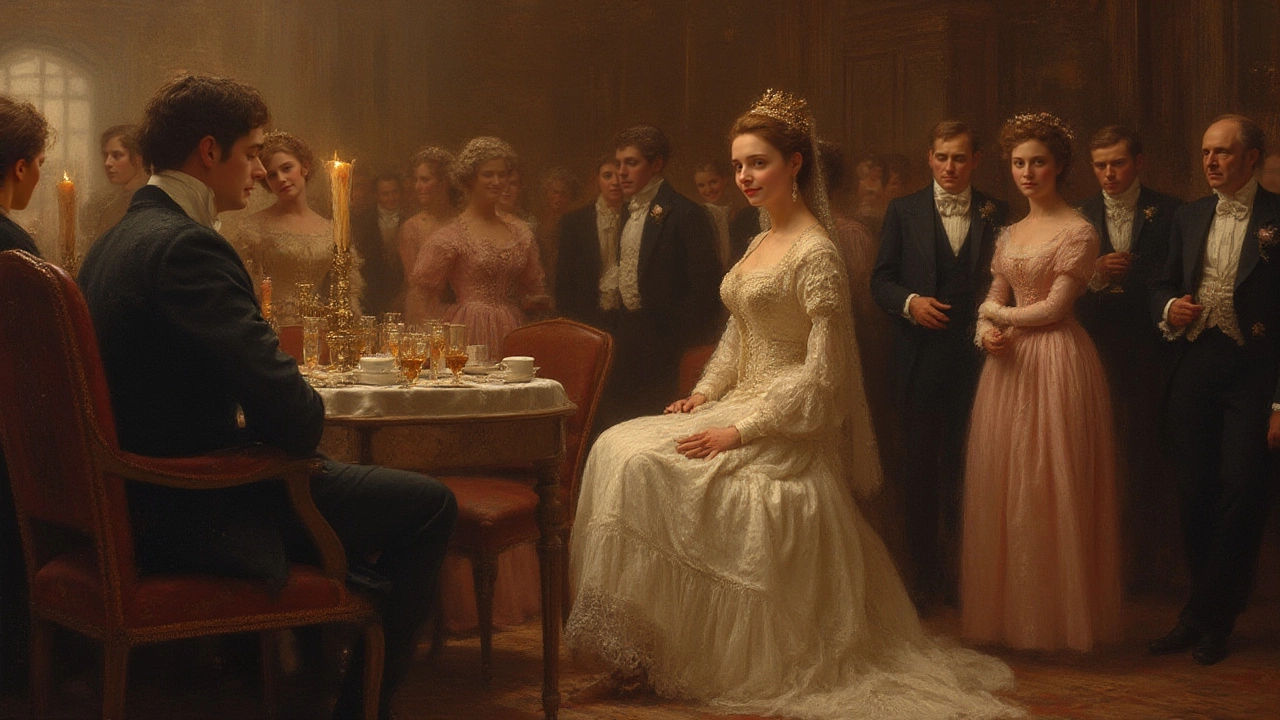If you’ve ever been to a wild wedding, chances are you’ve witnessed that awkward, often hilarious moment when the groom kneels in front of his new wife, dramatically slides his hands (or sometimes even his teeth!) up her leg, and triumphantly removes her garter before hurling it at a crowd of single guys. It’s a scene somewhere between a playful striptease and a public dare. But why do husbands actually remove the garter? The answer isn’t what you might expect, and trust me, it goes back way further than TikTok or even your grandma’s photo album.
Where Did the Garter Toss Really Come From?
Picture a time before sleek white dresses and picture-perfect photo booths—think medieval England, when your wedding night was definitely not a private affair. In those days, wedding guests were obsessed with nabbing a piece of the bride’s attire as ‘good luck.’ Some literally ripped fabric right off her dress (imagine Casper tugging at your sleeve until it tears, but a whole crowd doing it). Brides weren’t thrilled, so to keep guests from tearing her new outfit apart, the garter became the designated ‘token’ that could be removed and tossed, distracting eager partygoers and saving the dress.
By the 17th century, English and French wedding rituals had refined this into an actual ceremony, where the groom removed the garter and tossed it to the male guests. And yes, it was exactly as irreverent and raucous as it sounds. If you feel secondhand embarrassment for brides back then, you’re not alone.
This tradition didn’t stop in Europe. As folks crossed the Atlantic, they brought it to America, and it stuck, changing just enough each decade to keep people guessing about its origins. Some say the garter even signaled that the marriage had been consummated (awkward?!?). Others claim it simply carried forward the ‘good luck’ motif for bachelors hoping to wed next.
Want a fun stat? A 2020 survey by The Knot found about 50% of US weddings still include a formal garter toss. The numbers dip a lot in the UK and Australia, where old customs fade faster. Meanwhile, in Asia, the tradition barely registers unless it’s a westernized event.
A Symbol of Luck or Something Else?
So, is it all just quirky luck-chasing? Not exactly. At its core, the garter’s history is knotted up with fertility, protection, and even a dash of old-school superstition. When you look at early wedding rituals, the bride’s clothing carried deep symbolic meaning — from purity to warding off evil spirits, to bountiful home life. The garter, by extension, picked up those associations. Women wore it for ‘luck,’ but also because it was simply functional: who wants their stockings drooping down while dancing?
Over the centuries, as the role of superstition in marriage morphed, the garter turned into more of a playful nuisance than a serious blessing. Some old French traditions involved guests actually playing games to get the garter, often while the bride was still in her wedding dress (can you imagine the in-laws now?). In Victorian England, garter removal was sometimes done in private, but the decorum didn’t always stick. What stayed soft and sentimental in some places became a raucous centerpiece elsewhere.
Now, in 2025, people debate whether the whole garter event is empowering, outdated, or just goofy fun. But thematically, it’s almost never just luck: it’s mingled with ideas of prosperity, fertility, and a cheeky nod at the grown-up side of marriage. If you’re planning your own wedding, that history alone is enough reason to decide if it’s your vibe—or if you’d rather ditch it for something new.

Modern Spins: Keeping, Tweaking, or Skipping the Garter Toss
Today’s couples treat the garter tradition like a choose-your-own-adventure book. Some keep it classic, leaning into the campy humor. Others fix it so the groom removes the garter in a way that’s G-rated—no hands, just a smooth slide down the ankle, maybe while grandma claps along. Some creative couples toss the garter alongside a fun song, or even involve the bridesmaids and groomsmen as background dancers. (Yes, there are entire playlists dedicated to this moment—‘Pony’ by Ginuwine, anyone?). Then there are plenty who ditch it completely, arguing that a staged striptease just isn’t their jam.
One thing’s for sure: the rules are up for grabs. Some grooms practice in advance to avoid wardrobe malfunctions (tight elastic is nobody’s friend after a few cocktails). Brides, meanwhile, can choose ultra-pretty garters that match the wedding colors—sometimes even doubling as ‘something blue’ for that old rhyme. A lot of women buy a delicate one to keep and a cheap spare for tossing, in case things get rowdy.
Here are a few quick tips if you’re planning on including—or reimagining—the tradition:
- Check with your partner first. Not everyone’s into public leg-baring, and that’s totally okay.
- Pick a garter that feels comfortable. Some have scratchy lace or tight elastic—try before you buy.
- If you want great photos, consider a change of shoes or positioning the toss so your photographer captures all the action (or your face when you cringe).
- Make it your own. I’ve seen musical chairs, quiz games, and even charity raffles replace traditional tosses. It’s your day, after all.
- Prepare your MC or DJ—they’ll need to steer the crowd so things don’t get out of hand.
By far the biggest change is the attitude. The modern garter toss, when done, is usually done with a wink and a laugh—a way to break the ice after formalities. No one expects anything scandalous (well, almost no one). If you want something more private, there’s no pressure. Plenty of couples now remove the garter off-stage or skip it for a bouquet toss 2.0 (think potted plants, candy, or even custom snacks instead).
Interesting Garter Facts, Stats, and Alternatives
If you’ve stuck with me, you might know more about garters than you’ll ever need. But some trivia always wins at wedding parties, so here are a few gems:
- Garters for men—believe it or not—were a thing once, holding up men’s socks well into the 20th century. But nobody’s tossing those today (thank goodness).
- Royalty was into it: In 1348, England’s King Edward III made the Order of the Garter, a super-prestigious honor group, using the garter as a chivalric symbol.
- Modern-day brides sometimes wear two garters: one for tossing, one as a keepsake. It preserves the tradition without sacrificing your favorite lace.
- A quick table of modern garter toss preferences from The Knot’s US Wedding Survey 2024:
| Inclusion | % of Weddings |
|---|---|
| Traditional Garter Toss | 49% |
| Modified or Non-Physical Toss | 27% |
| No Garter Toss | 24% |
Not into the garter, but want to keep the spirit of fun? Try these alternatives:
- ‘Anniversary dance,’ where couples compete to see who’s been married longest.
- Custom game tosses—use a mini bouquet, plush toy, or themed favor instead.
- Charity raffle—guests enter and the couple donates in honor of the winner.
- Dancing shoes swap, especially great for outdoor weddings.
The thing to remember: traditions stick around because people bend and adapt them. If you love the silly spectacle of the wedding garter, go for it. If not, toss it out, literally or figuratively. Years from now, someone’s going to ask what you did at your wedding, and maybe you’ll have an epic garter saga—or a new tradition you invented yourself. I say: have fun, make it yours, and maybe keep that garter for your own scrapbooks—unless your kid decides to turn it into a headband for their toys. Ask me how I know.
